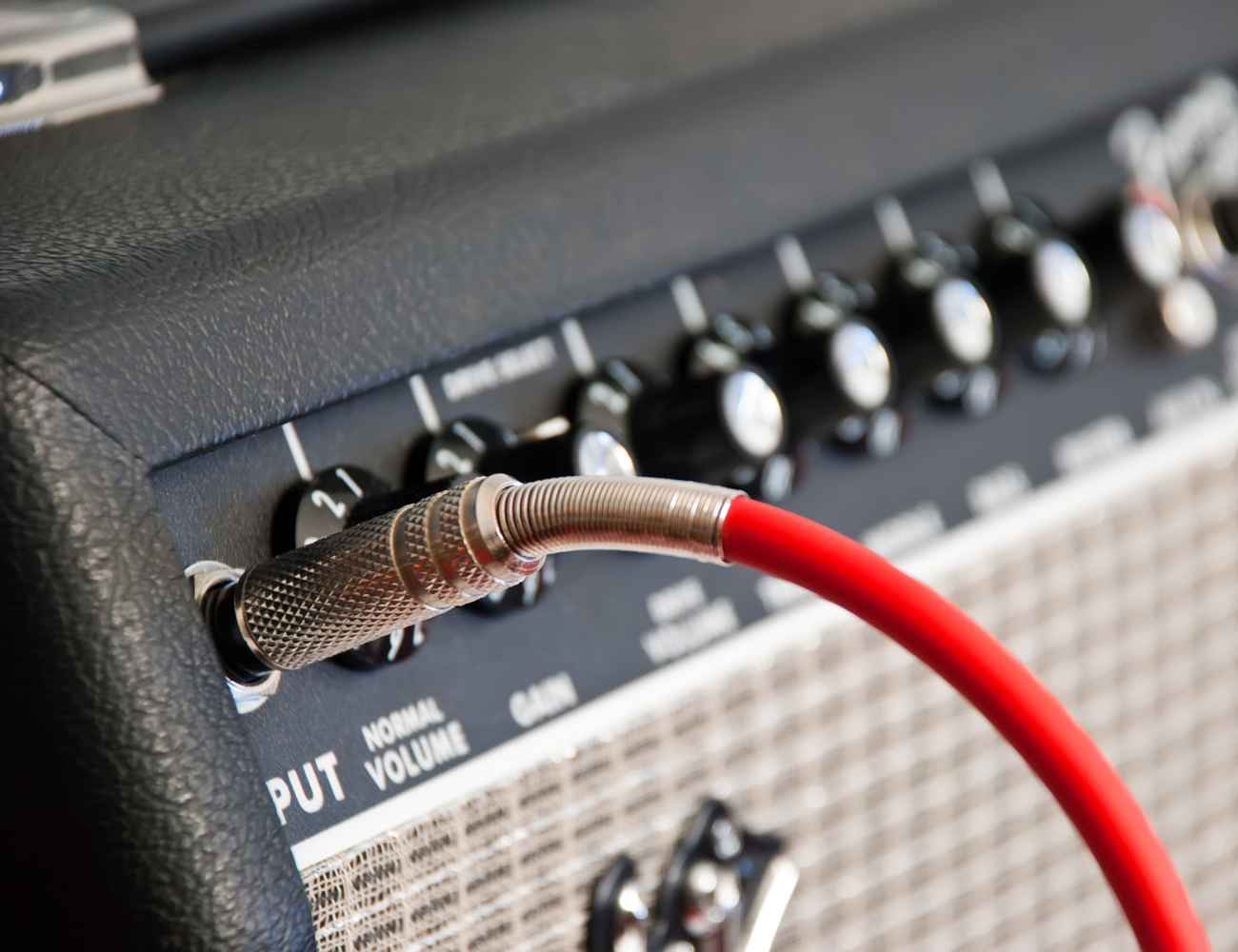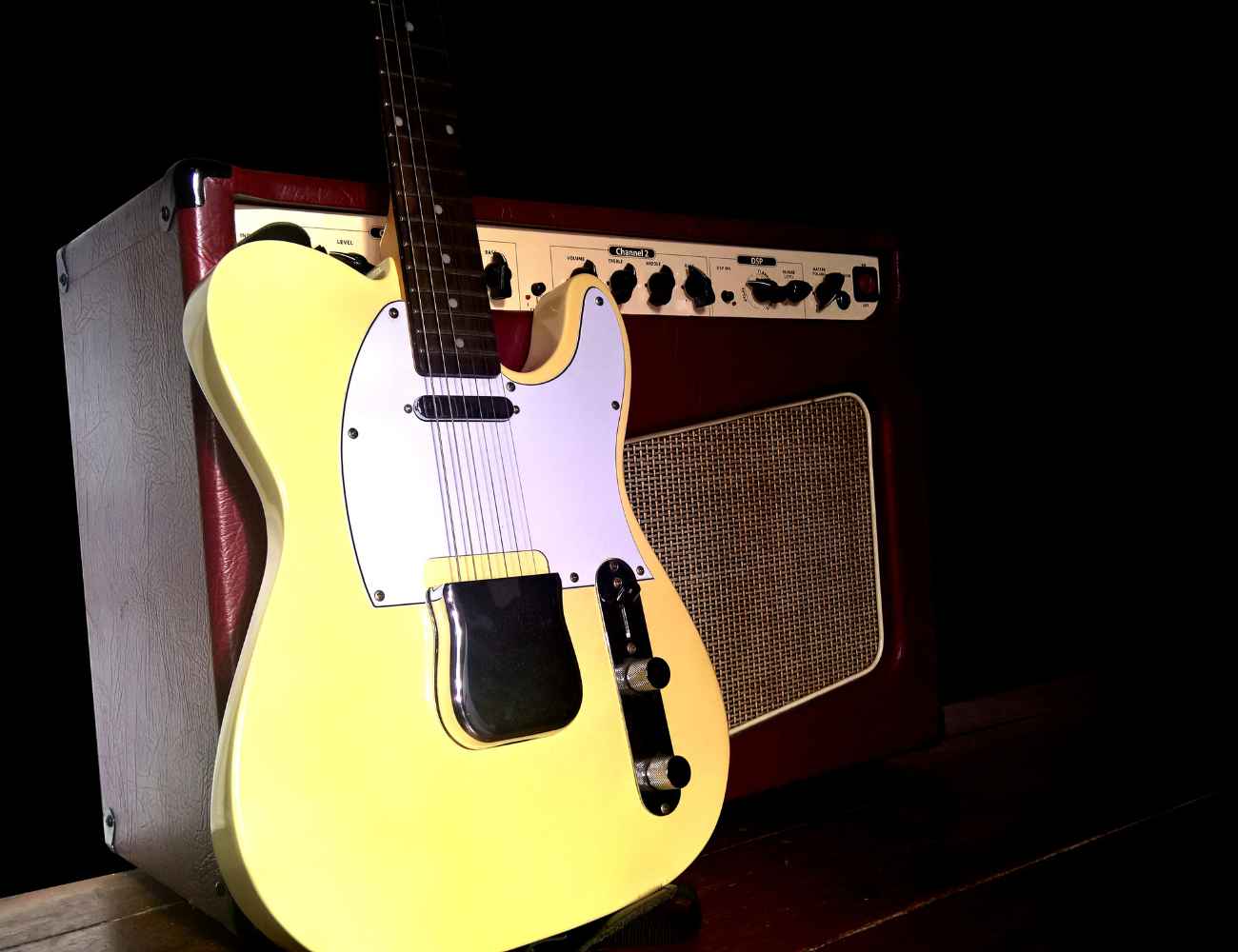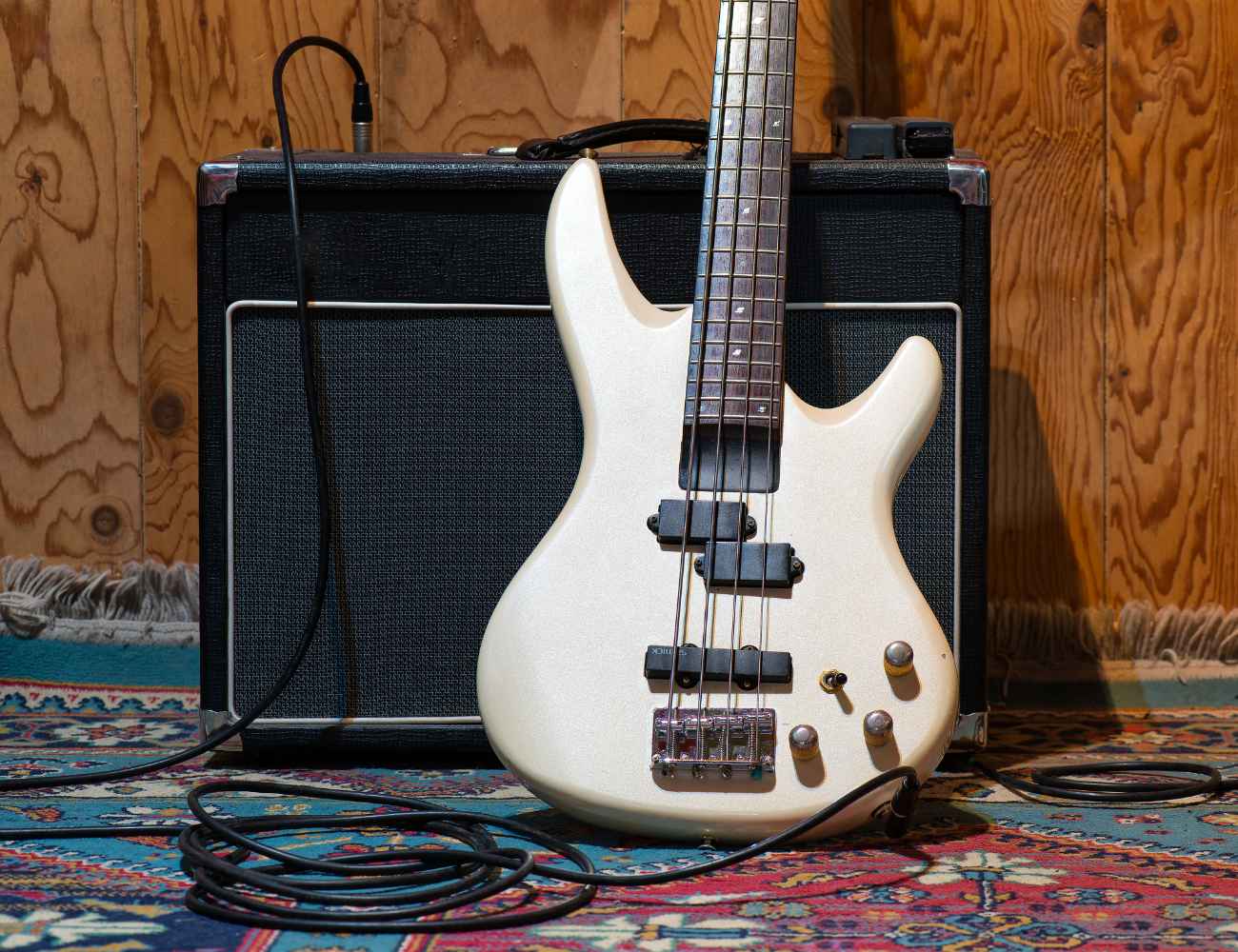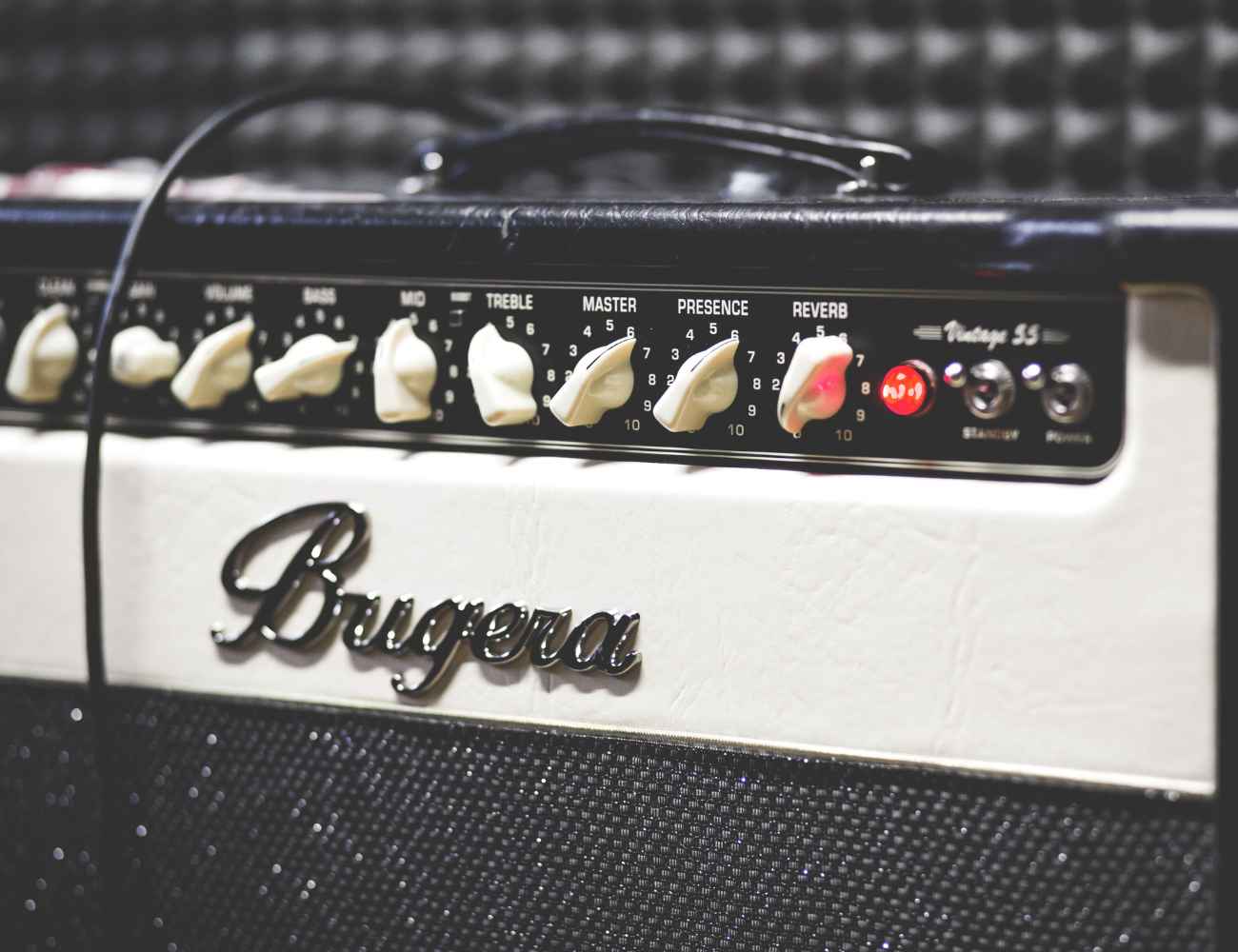What are the best solid state amplifiers?
Solid state amplifiers have become popular among music enthusiasts and professionals regarding high-quality sound reproduction.
These amplifiers are known for delivering precise and powerful sound without the distortion and noise that can sometimes be present with other amplifiers.
In this post, we’ll talk about the best solid state amplifiers today, considering sound quality, features, and price factors.
We’ll also answee some of the most frequently asked questions on this topic, so that you can make an informed desicion whenever you get a new one.
Table of Contents [show]
The Best Solid State Amplifiers
Marshall MG30GFX Amplifier
Powerful, reliable, feature-packed solid state amp.
The Marshall MG30GFX is a reliable and feature-packed solid state amplifier offering 30 watts of power, four channels, 3-band EQ, built-in effects, and a 12″ custom speaker. It is well built and comes with a footswitch for quick channel switching, making it a great value for the price.
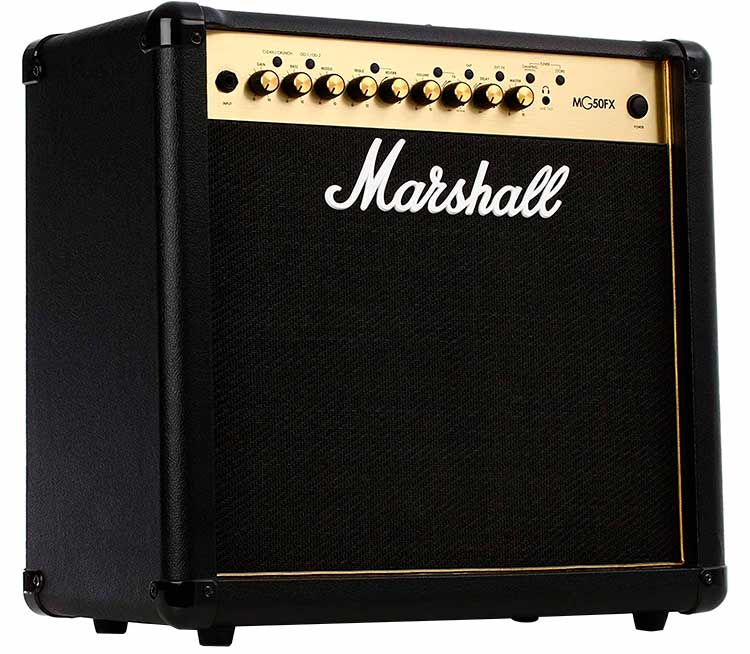
The Marshall MG30GFX is an excellent choice if you’re looking for a solid state amp with power, reliability, and many features.
It’s compact and lightweight – much more so than its tube-powered cousins – yet it still packs 30 watts of power, making it suitable for medium to large venues.
The four channels – Clean/Crunch and OD1/OD2 – offer guitarists bright cleans and JCM800-style distortion at the turn of a dial.
And to better shape your sound, the amp comes with a 3-band EQ. It also has built-in effects such as reverb, chorus, delay, and tap tempo switch, which can save you from buying additional pedals.
But the Marshall MG30GFX goes beyond just offering features. It is well built using MDF wood in its cabinet construction, giving the amp excellent acoustic properties.
Inside is a 12″ custom speaker that produces unique tones over the entire frequency spectrum.
It has a built-in tuner and a 2-button footswitch in the box – perfect for on-the-fly changes between channels without missing a beat.
All these features make this solid state amp stand out from the crowd compared to other models in its price range or even higher.
In addition, its affordability and reliable performance make this amplifier one of the best around today – delivering good sounds every time and ensuring you are always ready to rock!
- Pros:
- Powerful & reliable.
- Compact & lightweight.
- Versatile tones.
- Cons:
- None.
My final verdict is that the Marshall MG30GFX is an excellent choice for guitarists looking for a solid state amp that offers power, reliability, and plenty of features.
With its compact and lightweight design, four channels, 3-band EQ, built-in effects, custom speaker, and tuner, it delivers excellent value for its price.
The Marshall MG30GFX is well-built and offers reliable performance, making it one of the best amps around today.
Fender Champion 100 Amplifier
Versatile sound, great value, 100 watts of power.
The Fender Champion 100 is a powerful yet affordable solid state amplifier with two channels and a range of effects. It offers 100 watts of output power and two 12″ Fender Special Design speakers, plus four switchable voicings and a headphone jack for quiet practice.
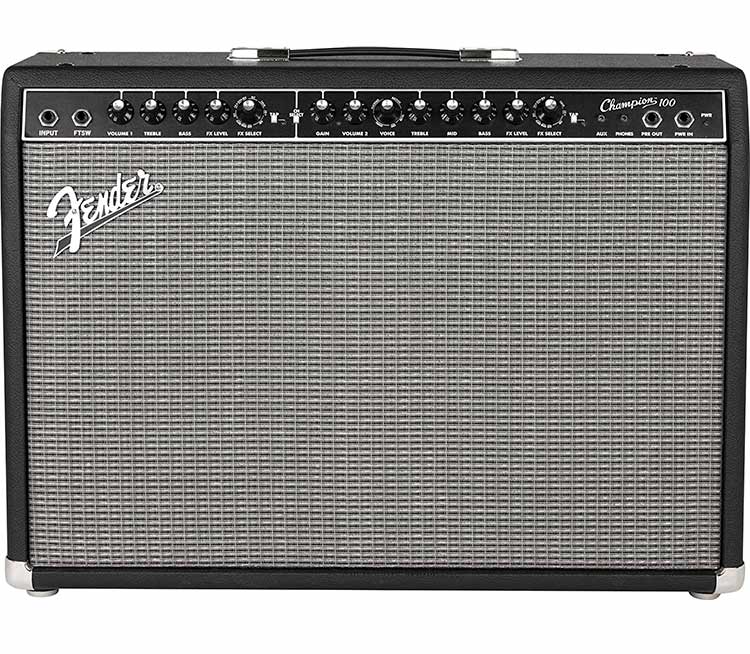
The Fender Champion 100 is a legendary solid state amplifier that stands out in affordable options.
With its extensive range of controls and effects, this amp can handle genres from blues to metal and provide great sound to fill up small-to-medium-sized venues. For under $500, it’s a great bang for your buck.
This classic model comes with two 12″ Fender Special Design speakers and boasts an impressive 100 watts of output power. It’s also convenient for those who wish to practice quietly since it offers a headphone jack.
On top of that, it has two channels: one clean channel and one drive channel with four switchable voicings – Tweed, British, Blackface, and Metal – all powered by the included footswitch.
The clean channel has volume, treble, bass, FX, select, and level controls, while the drive channel adds additional gain, middle, and bass settings, plus tone selector buttons to help shape your sound.
Further customization is possible via chorus, delay, reverb, flanger, and wah – all practical features that give you much control over your sound at this price point.
This amp holds up well with its traditional look featuring a black vinyl case, silver grille cloth, and even better-sounding tones.
From warm, clean tones to vintage blues sounds or modern metal riffs – thanks to its versatility, there’s something here for everyone regardless of musical style or preference.
Of course, this solid state amplifier may not have the same versatility as some of today’s more high-end digital amps.
Still, it does offer something simpler: excellent sound quality without being overly complicated – making it an ideal choice for guitarists everywhere!
- Pros:
- Quality sound for price.
- Versatile tones.
- Headphone jack.
- Cons:
- Not suitable for large venues.
- No digital features.
My final verdict is that the Fender Champion 100 is an excellent amplifier for the price.
With its extensive range of controls and effects and plentiful output power, it is great for guitarists of any genre and style.
The traditional look and warm, clean tones make it a great choice for those seeking a high-quality sound without the complexity of digital amps.
Boss Katana Mini Amplifier
Powerful sound in a tiny package.
The Boss Katana Mini packs a punchy 4” speaker, 7 watts of power, and legendary Boss modeling engine into an impressively small package, making it an ideal amp for home practice and recording. Its comprehensive control layout and dual power sources make it easy to take it anywhere.
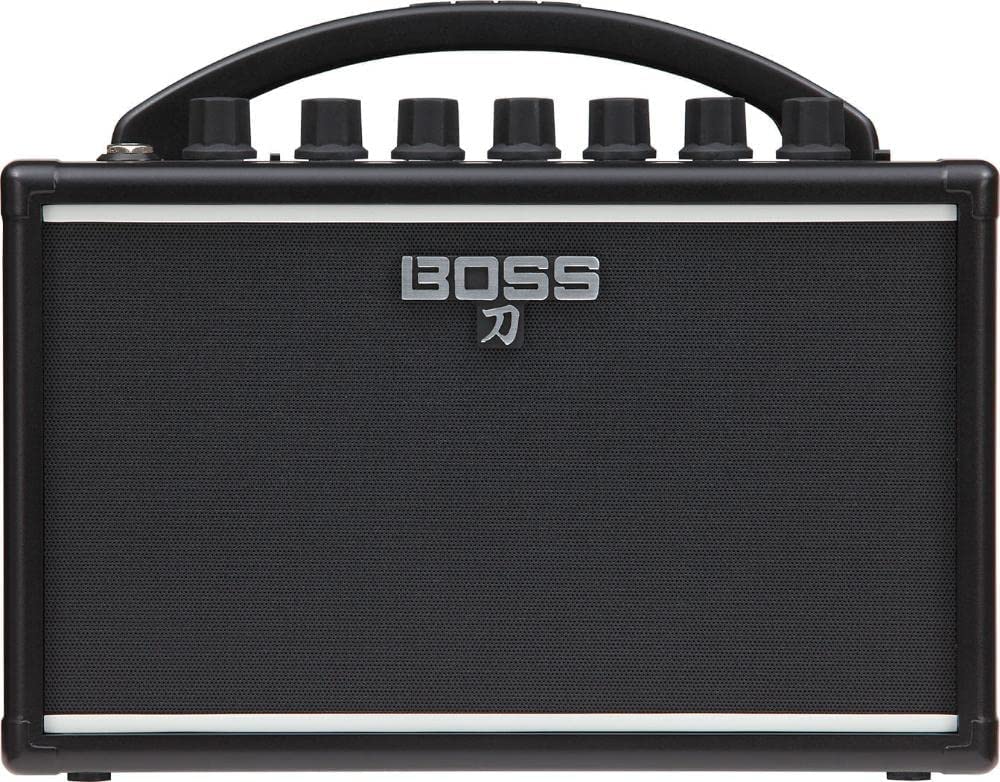
The Boss Katana Mini is a revolutionary amp that has transformed the mini amp category. It packs a punchy 4” speaker and 7 watts of power, enough to easily practice and even jam with friends.
With its superior sound quality and legendary Boss modeling engine giving it three distinct amp voicings – Clean, Crunch, and Brown – it certainly stands out from the competition.
The Katana Mini is incredibly light at just 2.6lb, and its housing is impressively durable too. Its speaker was especially remarkable, full sounding despite the low wattage output.
On top of that, it had a comprehensive control layout with three-band EQs, delay effects, and aux-in for accompanying tracks or drums. All this in such a small package!
So why is this solid state amp one of the best? Simply put, it does everything you need for home use without compromising sound quality or features.
This is your go-to choice for an amazing-sounding amp for practice or recording. Plus, you can take it anywhere hassle-free because of its dual power sources (battery/DC).
The downside is that because of its low wattage output, you won’t be able to keep up with a set of acoustic drums or loud environments.
However, if you are happy keeping it within bedroom levels, the Katana Mini will give you more than enough to work with!
- Pros:
- Superior sound quality.
- Legendary Boss modeling.
- Lightweight & durable.
- Cons:
- Low wattage output.
- Cannot keep up with drums.
- Bedroom-level only.
My final verdict is that the Boss Katana Mini is an excellent choice for home use, offering great sound quality and comprehensive controls in a lightweight and durable package.
It is perfect for practice or recording, and its dual power sources make it easy to take it anywhere.
However, its low wattage output may limit its ability to keep up with acoustic drums or in loud environments.
Line 6 Spider V 240HC Amplifier
Powerful, feature-packed amp head at great price.
Line 6 Spider V 240HC is a powerful solid state amp head with dual-purpose knobs, 128 presets, 200 amps, cabs, and effects. It offers 240 Watts of power for live venues and its array of presets allows for fast, accurate sound emulation.
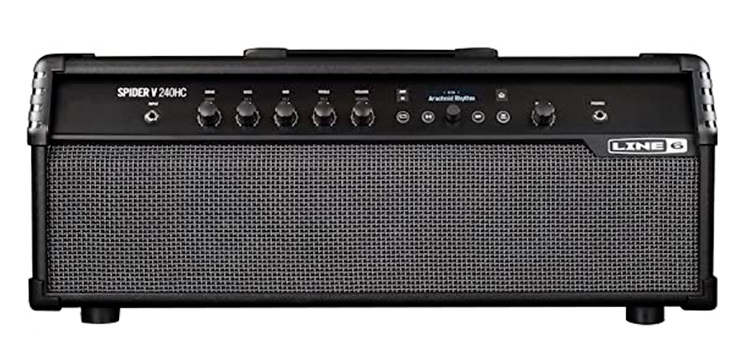
The Line 6 Spider V 240HC represents an innovative approach to amplifier design, offering a wealth of features and options that all come in a reasonably-priced package.
The control layout is simple yet intuitive, with dual-purpose knobs for easy navigation. The amp head has 128 presets, featuring over 200 amps, effects, and cabs built in.
Topping off the feature set is a power rating of 240 Watts, making this solid state head perfect for many live venues.
On top of its incredible list of features and specs, the tone coming out of this fantastic piece of gear is quite impressive. Presets are designed to emulate famous guitar players and popular albums accurately.
At the same time, effects range from digital to analog boutique quality, which is good enough for severe on-stage applications.
The Line 6 Spider V 240HC has been designed for musicians looking for plenty of power at a great price point.
It offers flexible control options with dual-purpose knobs and built-in speakers to make it a powerful amp head and an all-in-one solution when you’re on the road or don’t have accompanying speakers.
In addition, its array of presets allows you to dial in the perfect sound quickly, while its high wattage provides plenty of punch on-stage or in the studio. All in all, it’s one of the best solid state amplifiers on the market today.
- Pros:
- Dual-purpose knobs.
- 128 presets.
- 240 Watts.
- Cons:
- None.
My final verdict is that the Line 6 Spider V 240HC is an excellent option for musicians seeking a powerful and versatile solid state amplifier.
It offers an impressive range of features, intuitive control options, and plenty of wattage for live venues.
Plus, its built-in presets help you dial in the perfect sound quickly and easily.
Marshall Code 25W Amplifier
Compact, flexible, powerful – Marshall Code 25W.
The Marshall Code 25W is a fantastic value amplifier, offering an impressive range of features for just under $200. It offers 14 preamps, four power amps, and eight speaker cab emulations, plus 24 digital effects, 25 watts of power, a single 10″ speaker, and a headphone jack.
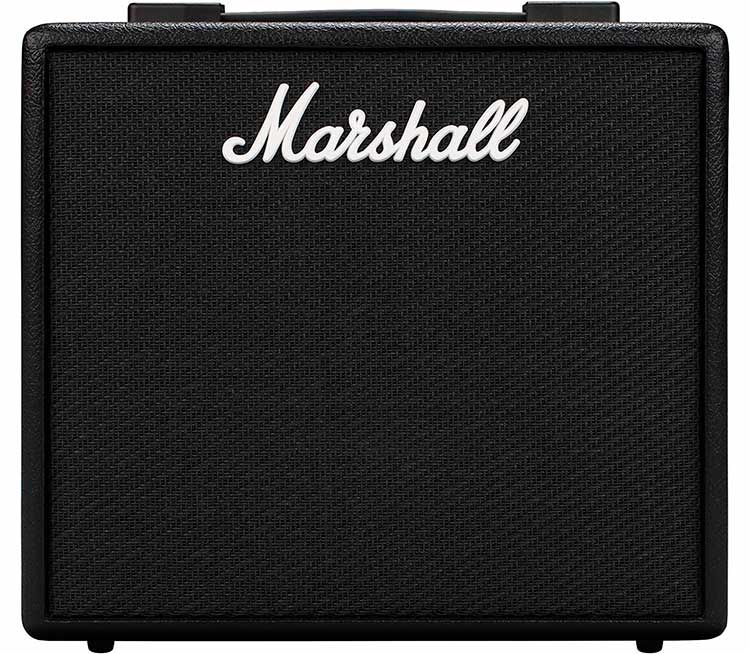
The Marshall Code 25W is a fantastic value amplifier that packs a huge range of classic Marshall tones into a compact and affordable package.
For just under $200, this solid-state combo amp comes with 14 much-loved preamps, four power amps, and eight-speaker cab emulations – all accessible through seven buttons and easy-to-use tone controls.
Not only does the Code 25W offer unparalleled flexibility in tone shaping, but it also includes 24 digital effects to enhance your sound further.
You can also customize any tone via USB or Bluetooth via the handy mobile app. Under the hood, this amp offers 25 watts of power with a single 10″ speaker, plus a headphone jack for those late-night practice sessions!
Performance-wise, the Code 25W delivers far more than its price tag suggests.
From crystal clear cleans to vintage Britpop crunch to searing-hot high-gain metal – this combo amp covers practically every musical style.
Of course, you won’t get the same level of power as you would from a 100-watt cab rig with four speakers, but it’s powerful enough for small gigs and recording work!
For players on a budget who want maximum flexibility at an affordable price point, there should be no hesitation in investing in the Marshall Code 25W amplifier.
It’s equipped with an impressive range of features that make it ideal for home practice sessions or even small gigs -and you will find only a few amps under $200 that can deliver such stunning results!
- Pros:
- Affordable price
- Flexible tone shaping
- Versatile sound
- Cons:
- Lower power
- Limited speaker
My final verdict is that the Marshall Code 25W amplifier is an excellent choice for players on a budget looking for maximum flexibility and performance in an affordable package.
From great clean tones to searing-hot metal, it has something to offer for practically any musical style, and its 24 digital effects and mobile app compatibility make it an even more attractive proposition.
Its 25-watt power and single 10″ speaker may not be enough for larger gigs, but it’s powerful enough for home practice sessions and recording work.
All in all, the Marshall Code 25W is a fantastic value amplifier that should not be overlooked.
Roland JC-120 Jazz Chorus Amplifier
Unmatched sound and features in a compact design.
The Roland JC-120 Jazz Chorus amp is a versatile solid state stereo amp with 120 Watts of power, two power amps, and classic silver cone speakers. It comes with intuitive controls, including 3-band EQ, distortion/Reverb knobs, and adjustable chorus, vibrato, and depth control.
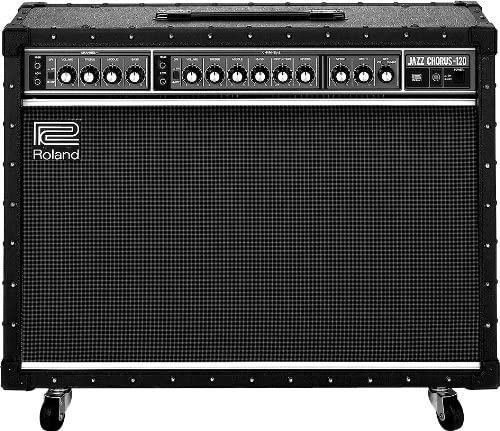
When you thought the best solid state amp was out of reach, Roland comes through with the JC-120 Jazz Chorus. This versatile stereo amp packs many features and can fit your budget – all while delivering incredible sound.
At first glance, you may need to be more impressed with its classic 80s/90’s design. But as far as controls go, it is surprisingly intuitive and tactile – making dialing in tones a breeze.
Two input channels each have their own three-band EQ, distortion/Reverb knobs, and an adjustable Chorus, Vibrato, and depth control cluster at the end. And those are just the basics!
The two power amps deliver an astonishing 120 Watts of combined power, enough to fill any room or performance space.
In addition, the classic silver cone speakers also provide unbeatable clarity and power handling for whatever type of sound you want to achieve. And if that wasn’t enough already, there’s also a stereo effects loop and footswitch for added convenience/flexibility.
The Roland JC-120 Jazz Chorus amp’s clean channel is considered one of the best in its class.
It provides a range of tonal options – from bluesy overdrive to smooth jazz chords – and even experienced musicians have praised the quality of sound it produces. The dual amplifier setup also gives it impeccable stereo sound, adding to its overall appeal.
And they had doubts about their existing pedals before plugging them in. In that case, they’ll quickly change their minds after testing Roland’s dual amplifier setup (which gives it impeccable stereo sound).
The Roland JC-120 Jazz Chorus solid state amp deserves well-earned recognition as one of the best amps under $1000 today.
Everything from its build quality to sound production is top-notch – combining affordability with top performance at every step.
With so many features packed into such a compact shell, it’s difficult not to be impressed by this equipment!
- Pros:
- 120 Watts combined power.
- Stereo sound.
- Effects loop.
- Cons:
- None.
My final verdict is that the Roland JC-120 Jazz Chorus solid state amp is an excellent choice for both experienced and novice musicians.
It provides unbeatable clarity and power, a range of tones, and an intuitive design that makes dialing in tones a breeze.
It is also an affordable option with top-notch build quality and sound production, making it one of the best amps available under $1000.
Roland Cube Street Amplifier
Portable, powerful amp with plenty of features.
The Roland Cube Street is a solid state amp that offers 8 COSM amp models, 6 digital effects, and 15 hours of battery life. It produces warm, rich sound and has 3 EQ controls and gain/volume knobs for guitar and mic channels, making it a great buy for those on a budget.

The Roland Cube Street solid state amp is one of the best in its price range due to its impressive features and performance.
This sub-$300 unit is designed for portability and convenience, making it ideal for home practice, lessons, street performances, or any other gigging situation.
It’s light but sturdy with a black case and silver grille, powered by two high-performance 6.5” neodymium speakers able to produce 5 watts of power per channel.
Performance-wise, this amp impresses with its COSM amp models offering eight different options, plus six digital effects, including chorus, flanger, delay, and tremolo.
The controls are also extensive yet easy to access on top of the amp – three EQ controls (bass, middle, and treble) and gain and volume knobs on the guitar channel.
In contrast, the mic channel includes two-band EQ (bass & treble), delay/reverb, and an output volume knob. Furthermore, there’s an auxiliary input for MP3s plus an AC adapter – which is excellent given that battery can also power it for up to 15 hours!
The sound quality produced from all these features is rich and varied, ranging from warm/jazz cleans to aggressive high-gain distortion tones that will suit rockers or metalheads alike.
It’s not the loudest amplifier in this price range but still enough for intimate settings like home practice or lessons.
In conclusion, if you’re looking for a reliably portable amp hat that packs plenty of powerful features without breaking the bank, look no further than the Roland Cube Street solid state amp!
- Pros:
- Portable & Convenient
- High-performance Speakers
- COSM Amp Models
- Cons:
- Not Loudest
My final verdict is that the Roland Cube Street solid state amp is an excellent choice for anyone looking for a reliable and portable amp that is packed with powerful features and produces a great sound quality for an affordable price.
Orange Crush 35RT Amplifier
Classic British tones, solid build, affordable price.
The Orange Crush 35RT is a 35-watt, solid state combo amp that offers classic British tones at an accessible price. It has two channels, aux-in capabilities, and a cab sim headphone out feature, providing plenty of versatility for any genre.
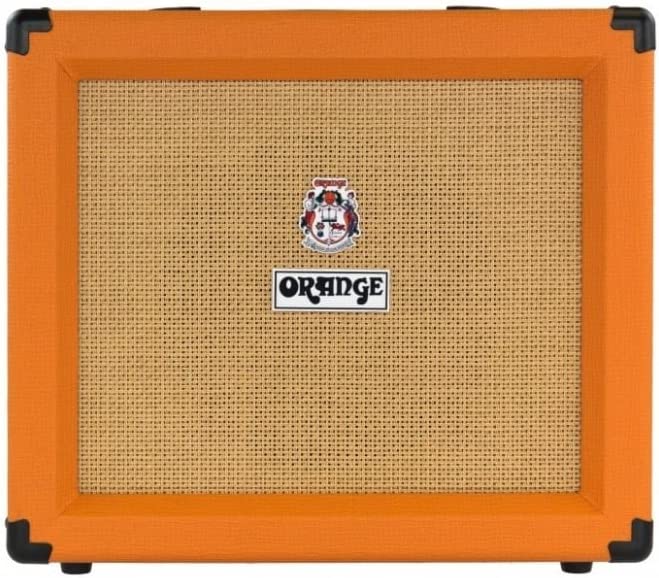
The Orange Crush 35RT is a fantastic option for anyone looking to achieve classic British tones without breaking the bank.
This 35-watt, solid state combo amp looks incredible with its iconic orange tolex and beige grille cloth finish, while its build quality is surprisingly high-end given its price point.
The 10” custom Orange “Voice of the World” speaker offers a tight and punchy sound with plenty of clarity, making it great for any genre from soft rock to metal.
It also has aux-in capabilities and a cab sim headphone out feature, emulating an orange 4×12” cabinet – perfect for playing without its built-in speaker.
Operation-wise, it has two channels (clean and dirty) and an FX loop, and a shared EQ section – the only downside is that we found the toggle switch for changing between channels was a bit small, which might prove tricky for people with larger hands.
The clean channel delivers nice and clear tones but can come off as thin for those not using preamp pedals.
The dirty channel, however, gives an organic sound and provides everything from crunchy rock tones to heavier distortion styles – precisely what you would expect from an Orange amp – making this amp very versatile.
To sum up, this amp looks great, is built well, sounds fantastic, and offers classic British tones at an attainable price.
Whether you’re practicing alone or performing on stage, it can handle all kinds of musical genres. As such, it certainly deserves consideration if you’re after reliable equipment that won’t break your budget.
- Pros:
- Classic British tones
- High-end build quality
- Versatile sounds
- Cons:
- Small toggle switch
- Clean channel thin
- No reverb
My final verdict is that the Orange Crush 35RT is a great choice for those seeking classic British tones at an affordable price.
Its build quality and sound are both top-notch, and its versatile tone and features make it suitable for any genre of music.
With aux-in capabilities and a cab sim headphone out feature, it is perfect for private practice or live performances, making it an excellent value for the money.
Yamaha THR10II Amplifier
Versatile, powerful, great-sounding: Yamaha THR10II amp.
The Yamaha THR10II is a powerful and feature-rich, solid state amp with 15 guitar amp models, 3 bass amp models, and 8 effects. It also includes 3.5mm headphone output, USB connection, Bluetooth connectivity, and MIDI interface for versatile performance.
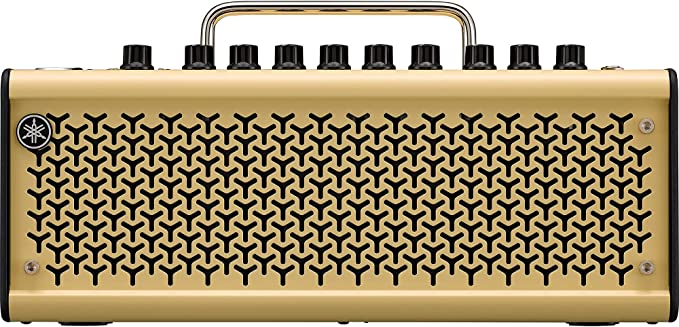
The Yamaha THR10II is an impressive little amp that looks as good as it sounds. It’s perfect for bedroom practice, recording, and playing shows at smaller venues.
With 15 guitar amp models, three bass amp models, three mic models for acoustic electrics, and three flat voicings for keyboards, synths, and vocals, this solid state amp offers many tonal possibilities.
Featuring five classic guitar amp models along with ten additional ones that you can access via the app, the THR10II ensures you have great-sounding tones no matter what style of music you play.
In addition, the USB connection makes it easy to record your performances right into your digital audio workstation (DAW) software of choice.
For those who want to use their headphones while playing, a 3.5mm headphone output gives you a great monitor mix for silent playing. And despite its small size, the THR10II still packs plenty of power – delivering 20 watts of punch!
Regarding feature sets, the THR10II comes with eight different effect types, such as Reverb and Chorus – allowing you to shape your sound further than ever before.
There’s also a built-in MIDI interface, so you can easily control other MIDI devices from your amp. Moreover, Bluetooth connectivity is included to make streaming audio from various sources convenient and hassle-free.
The THR10II is lightweight enough to take on the go if required but stylish enough to look good when placed in any space.
Its top control panel is clear and easy to use, while its 2 x 3-inch speakers come with excellent stereo separation – making these amps incredibly versatile units capable of producing unique sounds!
All in all – it’s one of the best solid state amps available today and worth considering when looking for an affordable practice amplifier or small-venue combo system that sounds incredible in any situation!
- Pros:
- 15 amp models.
- USB connection.
- 3.5mm out.
- Cons:
- Small size.
- No tubes.
- 20 watts max.
My final verdict is that the Yamaha THR10II is a great choice for any musician looking for an affordable and reliable practice amp or small-venue combo system.
With its impressive selection of amp models, effects, and other features, as well as its stylish design, this solid state amp packs plenty of punch and provides great stereo separation for unique sounds.
Fender Tone Master Princeton Reverb Amplifier
Classic Fender sound in a portable, reliable, and affordable package.
The Fender Tone Master Princeton Reverb is a reliable and versatile solid state amp, delivering 12 watts of power with classic Fender looks and tone. It has all the controls you’d expect from a vintage tube amp plus convenient portability, with a two-button footswitch included.
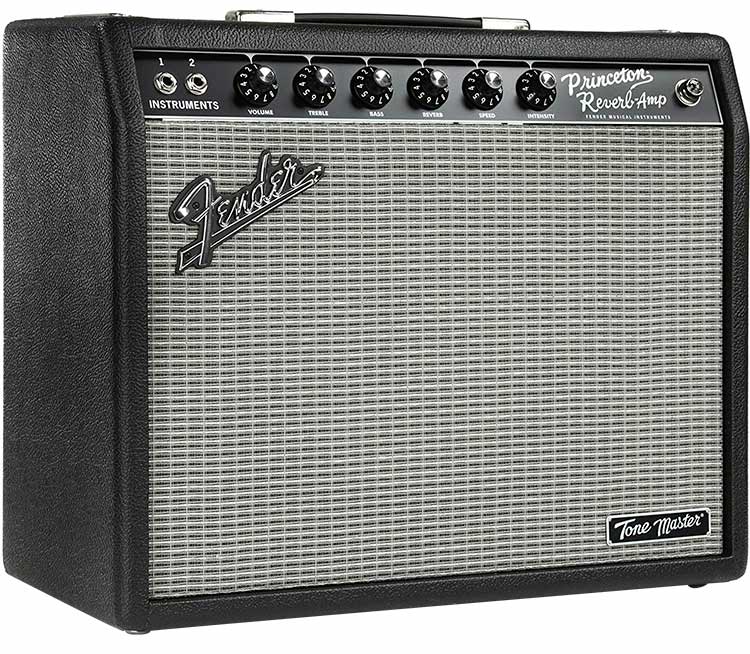
Despite its small size and stature, the Fender Tone Master Princeton Reverb is an incredibly versatile and robust solid state guitar amp.
No matter what genre you play, from blues to rock or even metal, this amp will give your performance that legendary Fender tone and clarity musicians have loved for decades.
The Tone Master features twelve watts of power via a Jensen C-10R 10″ speaker, delivering excellent balance throughout the entire frequency range.
On top of that, the classic design looks just like its ’65 tube counterpart – except for the Tone Master logo visible on the lower right corner of the grille cloth!
For sound shaping, it has all the same controls you’d expect from a vintage tube amp: volume, treble, and bass knobs in an EQ section as well as separate controls for reverb levels, speed, and intensity.
As a result, its tones are vibrant, complete, and clear – especially the cleans, with plenty of headroom retained no matter how loud you turn it up.
Plus, with a two-button footswitch included in the box at no extra cost – which lets you remotely activate the reverb function – this amp becomes even more desirable as a gigging musician’s go-to option due to its portability and reliability.
While it may not have mids control for more complex tones, there’s little else needed here to get that classic Fender sound delivered accurately with its all-digital design.
Thanks to its lightweight build – weighing only 27 lbs – transporting it is easy.
And because of its solid state technology, there’s no risk of expensive maintenance costs compared to tube amps, either!
Furthermore, you can dial down strength from 12 to 0.3 watts using built-in attenuation if you want terrific sounds at quieter levels without sacrificing tone quality.
Overall, if quality tones out of a reliable amp are what you’re after – regardless of genre – you won’t find many better options than Fender’s iconic Tone Master Princeton Reverb model.
It delivers those classic looks and provides consistent audio performances every time – all while being one of the best affordable options today!
- Pros:
- Classic Fender sound.
- Two-button footswitch.
- Lightweight build.
- Cons:
- No mids control.
- No tube technology.
- Expensive for some.
My final verdict is that the Fender Tone Master Princeton Reverb is an incredibly well-rounded, versatile solid state guitar amp that delivers classic Fender tones with clarity, plenty of headroom, and a reliable design.
With built-in attenuation and a two-button footswitch included at no extra cost, it’s an excellent choice for gigging musicians looking for great sounds without the risk of expensive maintenance.
Marshall Code 50 Amplifier
Iconic tones, easy control, portable size.
Marshall Code 50 is a versatile solid state modeling amp with 14 MST preamps, 4 MST power amps, 8 MST speaker cabs, 24 FX, and optional footswitches. It also offers Bluetooth streaming, 1x instrument and 1x 3.5mm aux inputs, and headphone output. Ideal for advanced guitarists and beginners alike.
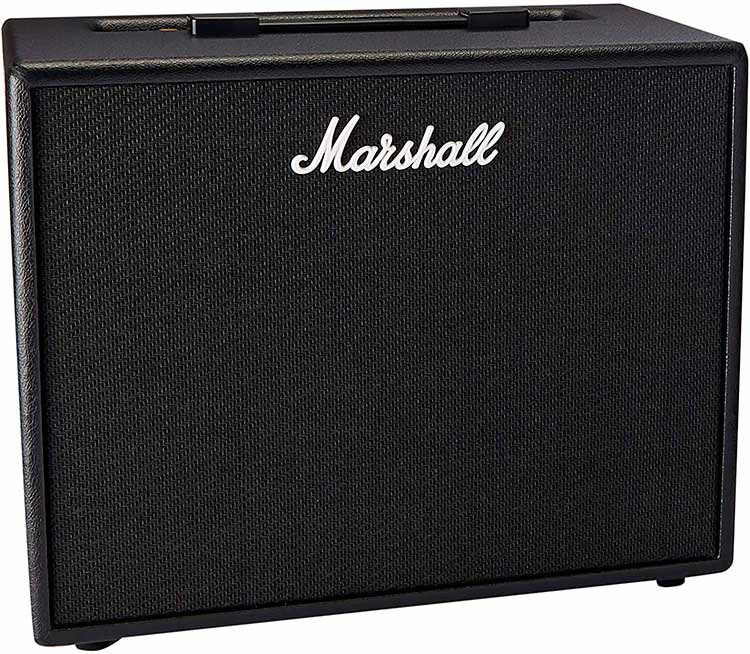
The Marshall Code 50 solid state combo modeling amp is the perfect all-in-one solution for guitarists who want to access an array of iconic tones.
Developed in collaboration with ‘rock and roll scientists’ Softube, this remarkable amp features 14 MST preamps, 4 MST power amps, 8 MST speaker cabinets, plus 24 effects. All can be easily controlled via the intuitive control panel or Marshall’s Gateway app.
Whether you’re seeking a classic JTM45 tone or something more modern like a JCM800 2203, Code 50 covers you.
With its included Bluetooth streaming capabilities, you’ll always have jam tracks to practice and play along with. At just 29 lbs (13kg), it’s light enough for portability but powerful enough for gigs.
Code 50 also has optional footswitches that enable hands-free operation for added convenience.
In addition to providing 1 x instrument and 1 x 3.5mm aux inputs (and headphone output), this versatile amp also includes additional features that set it apart from other modeling amps on the market: its generous number of FX options and small footprint size.
Guitarists looking for an amp that captures some of rock music’s most celebrated tones will fulfill their dreams with the Marshall Code 50 modeling amp.
Additionally, beginner players may appreciate its ease of use, and intermediate-level players will be pleased with its incredible versatility as they master their craft.
- Pros:
- 14 preamps.
- 24 effects.
- Bluetooth streaming.
- Cons:
- Optional footswitches.
- Not for beginners.
- Limited options.
My final verdict is that the Marshall Code 50 solid state combo modeling amp is a great choice for guitarists of all skill levels.
It is incredibly versatile, offering a wide range of tones, effects, and Bluetooth streaming capabilities.
It is also lightweight and easy to use, making it an ideal choice for both experienced and novice players.
Fender Tone Master Deluxe Reverb Amplifier
Authentic Fender sound and features, no maintenance.
The Tone Master solid state amp features an attenuator dial and XLR out to achieve iconic tones at home without noise complaints and provides a consistent, classic Fender tone without needing maintenance. It looks and sounds like a tube amp, but is much lighter and cheaper.
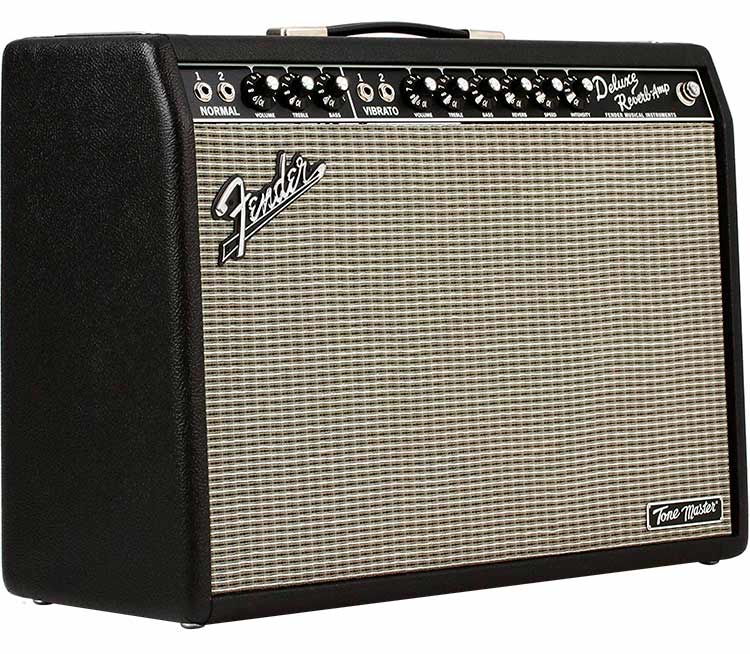
The Tone Master solid state amp is among the best on the market for various reasons.
On the surface, it looks just like its tube-driven counterparts with its 12″ Jensen speaker and silver grille cloth adorned by a Tone Master badge.
However, this version has two game-changing additions not found in tube amps: an attenuator dial and XLR out.
The attenuator dial allows you to lower the 22-watt output power (the same as a tube amp) to 0.2 watts.
So you can achieve those iconic saturated tones at home without bothering your neighbors. The XLR out has a cab sim switch that lets you choose between flat or two-mic IRs, an SM57, or a ribbon – giving you great recording options inside and outside the studio.
Sound-wise, this amplifier is hard to differentiate from its tube counterpart, despite being twice as light and half the price.
It’s true to the classic Fender tone but with complete consistency due to no degrading valves over time, something that can’t be said for its tube equivalent, which undergoes wear and tears even when not in use.
And there’s no need to worry about presets or LED screens here – plug in and enjoy 22 watts of full-fat Fender goodness!
So why should you get this solid state version over any other? Not only does it look exactly like the real thing – it sounds exactly like it too!
And with no need for maintenance and two industry-leading features built in, looks don’t deceive here!
- Pros:
- Attenuator dial.
- XLR out & cab sim.
- No maint. required.
- Cons:
- None.
My final verdict is that the Tone Master solid state amp is an excellent option for anyone who wants to achieve iconic saturated tones without disturbing their neighbors.
It offers the same sound and look as a tube amp, with the added bonus of an attenuator dial and XLR out for recording options.
It’s also twice as light and half the price, with no need for maintenance, making it a great value for money.
Blackstar Silverline Deluxe 100W Amplifier
Limitless tonal control, superb value & quality, modern tech.
The Silverline Deluxe Head by Blackstar is a versatile 100W solid state amp with ISF and Response controls, effects loop, and USB connection, that allows for infinite tonal possibilities. The Celestion V-Type speaker cabinet completes the live setup, ensuring exceptional sound quality.
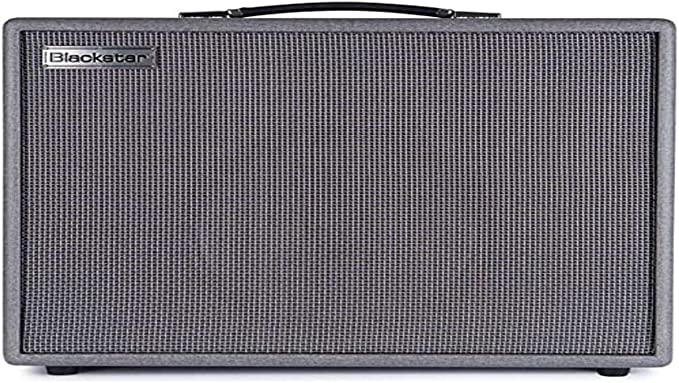
The Silverline Deluxe Head by Blackstar is among the best solid state amps to invest in due to its versatile feature set and fantastic tone.
This combo amp boasts 100W of power, one instrument input, one MP3/line input, and two parallel speaker outputs.
It comes equipped with multiple reverb, modulation, delay effects, and an effects loop for further customizing your sound.
Additionally, it has a headphone-out option for silent practice or recording and a USB for use with the free Architect software by Blackstar.
Perhaps the most significant selling point of this amp is the immense tonal control it provides thanks to the Bass, Middle, and Treble settings, which you can adjust in conjunction with the ISF (Infinite Shape Feature) control that lets you choose between a British or American sound – or any combination thereof.
Moreover, a Response control allows you to emulate various valve sizes from EL84s to KT88s.
Combined features will enable you to experiment endlessly with almost infinite musical possibilities.
In terms of build quality and value for money, this amp is good as its 38.4 lbs/17.4kg frame does not skimp on modern-day necessities such as USB connections while keeping the weight low enough for easy portability.
Powering up the matching 2 x 12” Celestion V-Type speaker cabinet completes the live setup, or using an emulated line-out direct into PA systems gives excellent results too.
The Silverline Deluxe Head by Blackstar covers nearly everything – excellent build quality, superb value for money, and infinitely adjustable tones.
It also features technology that allows even deeper exploration, providing players endless opportunities to find their perfect sound.
- Pros:
- Versatile feature set.
- Fantastic tone.
- Infinite customizations.
- Cons:
- None.
My final verdict is that the Silverline Deluxe Head by Blackstar is an excellent amp to invest in due to its versatile features, great tone, and incredible value for money.
It provides immense tonal control and countless musical possibilities, making it a great choice for both live and recording purposes.
Yamaha THR5 Amplifier
Compact, versatile, great sound: the perfect all-in-one amp.
Yamaha THR5 is a versatile acoustic amp with five distinct voicings, four reverbs, delays, and modulation settings, plus USB output and software editor app. It’s an ideal all-in-one solution for recording or home practice sessions.
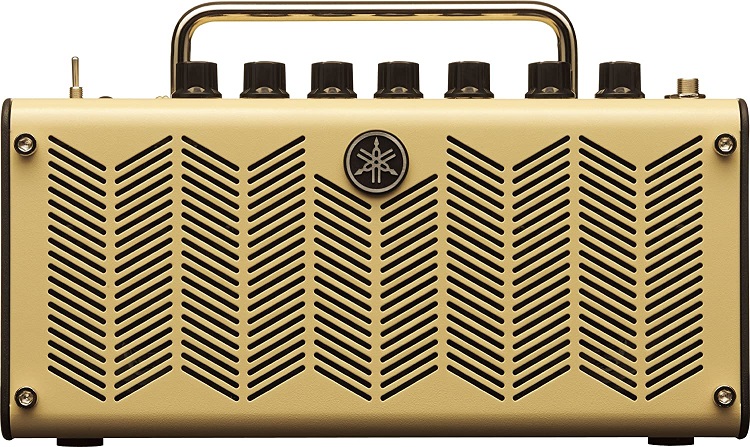
The Yamaha THR5 is one of the best solid state amps available. In addition, this amp comes in a compact package that exudes style, making it a perfect fit for your living room while still providing superb sound quality.
The THR5 has five distinct amp voicings: Clean, Crunch, Lead, Brit Hi, and Modern. Each voicing provides a clear and crisp sound with a dynamic range of tones.
For example, the Clean setting is bright and clear for pristine clarity, the Crunch setting gives you some vintage guitar overdrive tones, and the Brit Hi setting sounds like classic Marshall Plexi-style rock ‘n roll.
In addition to its sonic versatility, the Yamaha THR5 has plenty of built-in recording features.
It features four reverbs, delays, and modulation settings to get creative with your tone.
In addition, recording your playing can be done easily using the USB output function, which allows you to connect directly to a computer without any additional hardware required.
Last but not least, this amp can also act as an interface with its software editor app.
While it isn’t the most intuitive user experience due to clunky software design, it still provides users with more options when recording their playing or practicing at home.
For these reasons alone, it’s no wonder this amp is a popular choice amongst players worldwide – it offers form and function in one impressive package!
With its high-quality sound output and attractive design, this solid state amp is undoubtedly one of the best on the market today for those looking for an all-in-one solution for recording or practice sessions at home.
- Pros:
- Five amp voicings.
- Built-in recording.
- Software editor app.
- Cons:
- Clunky software.
- Intuitive user exp.
My final verdict is that the Yamaha THR5 is a great choice for players looking for versatility and style in one impressive package.
With its high-quality sound output, five distinct amp voicings, and built-in recording features, this amp is undoubtedly one of the best on the market today.
Boss Katana 50 MKII Amplifier
Vast range of tones, great sound quality, and aftermarket support.
The Boss Katana 50MKII offers classic tones and big rock sounds plus a range of effects for players of all levels. With adjustable wattage and a companion software for intuitive adjustments, it’s a powerful, cost-effective amplifier for any situation.

The Boss Katana 50MKII is an impressive and cost-effective solid state amplifier that offers features for players of all levels.
It has a sturdy build, attractive design, and is incredibly powerful, all for under $300.
The amp boasts five different voicings with adjustable three-band EQs, giving users a vast range of tones.
Plus, it’s packed full of effects options like reverb and delays to help create unique textures.
For those more interested in the traditional sounds, the Katana can serve up some great cleans, crunch, and distortion right out of the box.
The Katana offers excellent sound quality and is perfect for stage or studio use thanks to its intuitive companion software that allows users to make fast adjustments on stage or record directly into a DAW using USB interface functionality.
When you add its attenuator switch, which lets you adjust between 50, 25, and 0.5 watts – making it ideal for practice sessions, too – this small but mighty amp ticks all the boxes.
This amp will always be there if you’re after classic tones or big rock sounds.
On top of this, it also comes with colossal aftermarket support from the online Katana community, who share profiles and models for every tonal need imaginable.
This sets this amp apart from anything else on the market: it’s no wonder it’s still one of the most well-known amps today!
- Pros:
- Cost effective.
- Tones & effects.
- Intuitive software.
- Cons:
- None.
My final verdict is that the Boss Katana 50MKII is an outstanding solid state amplifier with a range of features and tones at an unbeatable price.
It is well-built, versatile, and perfect for both live and studio applications.
With its attenuator switch, quality sound, and extensive aftermarket support, this is a great choice for all levels of players.
What is a solid state amplifier, and how does it differ from a tube amplifier?
A solid-state amplifier is an electronic device that amplifies an audio signal using transistors, diodes, and other solid-state components.
It differs from a tube amplifier in a way that this one uses vacuum tubes to amplify the signal.
Solid-state amplifiers are more commonly used today due to their increased reliability, lower maintenance requirements, and more affordable price points.
One of the main differences between solid-state and tube amplifiers is how they distort the audio signal.
Solid-state amplifiers produce a cleaner, more transparent sound with less harmonic distortion, while tube amplifiers are known for their warm, rich, and harmonically complex sound.
This difference in sound can be both a blessing and a curse, depending on the type of music and playing style.
Another difference between the two types of amplifiers is their power output.
Solid-state amplifiers can deliver high power outputs at low distortion levels, making them ideal for high-gain genres like metal and hard rock.
On the other hand, Tube amplifiers tend to produce more distortion at high volumes, which can be desirable for certain styles of music.
Another thing you’ll find is that solid-state amplifiers are also lighter and more portable than tube amplifiers, making them easier to transport to gigs and rehearsals.
They are also more reliable than tube amplifiers, as they do not require the regular replacement of tubes or other components.
What to look for when selecting a solid state guitar amplifier?
When selecting a solid-state guitar amplifier, there are several features to consider that can significantly impact your playing experience.
Here are some points to keep in mind:
– Power Rating
The power rating of a solid state amplifier is an important consideration when selecting an amplifier suitable for your needs.
The power rating determines how loud the amplifier can get and how it affects the overall sound quality.
For home practice or small gigs, a lower power rating of around 10-30 watts may be sufficient to achieve the desired sound levels.

However, for larger venues or performances where you need to compete with other instruments or amplifiers, a higher power rating of 50 watts or more may be necessary to ensure that your sound can be heard clearly.
It’s important to note that a higher power rating does not necessarily mean better sound quality.
For example, a higher-wattage amplifier may have more headroom, which means it can handle higher volumes without distortion and produce more unwanted noise and hiss.
A lower-wattage amplifier can make a more compressed, saturated sound desirable in specific genres.
When selecting an amplifier, it’s essential to consider the size of the venues where you will be playing and the other instruments you will be playing alongside.
This can help you determine the appropriate power rating for your amplifier to ensure your sound is heard clearly and with the desired tone and quality.
– EQ Controls
EQ controls allow you to adjust the frequency response of your amplifier to shape your sound to your liking.
A comprehensive EQ section with precise controls can help you achieve the sound you want, whether playing in a small bedroom or a large concert venue.
Bass controls allow you to adjust the low frequencies of your sound, for example, boosting the bass can give you a warm, round sound, while reducing the bass can give you a cleaner, more articulate sound.
Midrange controls adjust the frequencies in the middle of the sound spectrum.

Boosting the midrange can give you a more forward, aggressive sound while reducing the midrange can provide you with a more scooped, modern sound.
Treble controls adjust the high frequencies of your sound.
Turning the treble up can give you a brighter, more cutting sound, while reducing the treble can give you a warmer, more mellow sound.
Precise EQ controls can be critical if you play in different venues or with other bands.
For example, if you’re playing in a small room with boomy acoustics, you may want to reduce the bass to avoid muddiness.
On the other hand, if you’re playing in a large concert hall, boosting the midrange to cut through the mix can be something you can do to sound better,
– Built-in Effects
Built-in effects can be convenient for guitarists who want to experiment with different sounds without purchasing and carrying around separate pedals.
Effects like reverb, delay, and chorus can add depth and character to your playing and help you create a unique sound.
Some amplifiers may offer a variety of built-in effects, while others may only have a few primary effects.
Therefore, it’s essential to consider which effects you use most often and look for an amplifier that includes them.
It’s worth noting that built-in effects may not always be as high quality as dedicated pedals.
Consider using separate pedals if you are particular about your effects or require a more advanced control level.
Additionally, some amplifiers may offer the ability to connect external effects pedals for even more versatility.
Which I think can be a good option if you already have a collection of pedals you like to use and want to integrate them with your amplifier.
– Footswitch compatibility
Footswitch compatibility is important when selecting a solid state guitar amplifier, especially if you plan to use it for live performances.
A footswitch allows you to change between channels, turn effects on and off, and switch between different modes with your feet without interrupting your playing or needing to adjust the amplifier physically.
This can be particularly useful during live shows, where you must quickly change your tone or effects between songs.
When selecting an amplifier, check if it has a dedicated footswitch jack or is compatible with a generic footswitch.
Some amplifiers include a footswitch, while others may require purchasing it separately.
Also, make sure to check the compatibility of the footswitch, as not all footswitches are interchangeable with all amplifiers.
Some amplifiers may only have one or two channels that can be switched with a footswitch, while others may have multiple channels or effects that you can change.
The more foot-switchable options you have, your amplifier will be more versatile in different performance situations that it will be, which is a nice touch.
– Speaker Configuration
The speaker configuration of an amplifier is an essential factor to consider when selecting a solid state amplifier.
The type and number of speakers can significantly affect the amplifier’s sound quality, as well as its overall size and weight.
A single speaker is a standard configuration for smaller practice amplifiers, while larger amplifiers often have multiple speakers.
Amplifiers with two speakers are called 2×12 or “two-by-twelve” amps, while those with four speakers are named 4×12 or “four-by-twelve” amps.
The speaker configuration also affects an amplifier’s size and weight a lot.
Generally, the more speakers an amplifier has, the larger and heavier it will be, which again, this can impact the portability of the amplifier, so consider your needs before selecting an amplifier with a specific speaker configuration.
It’s also important to consider how the speaker configuration affects the amplifier’s sound.
For example, a single 12-inch speaker may provide a punchier, more focused sound, while a 2×12 or 4×12 configuration can give a fuller, more expansive sound.
In addition, different genres of music may call for different speaker configurations, so consider your playing style and the type of music you typically play when selecting an amplifier.
– Build Quality
When looking for a solid state guitar amplifier, the build quality is an essential factor to consider.
Even though solid-state amps are generally known for their reliability, they are still prone to wear and tear, especially with regular use and transportation.
Therefore, selecting an amplifier that can withstand these conditions is crucial.
When evaluating the build quality, consider the materials used to make the amplifier and also even the reputation of the brand.
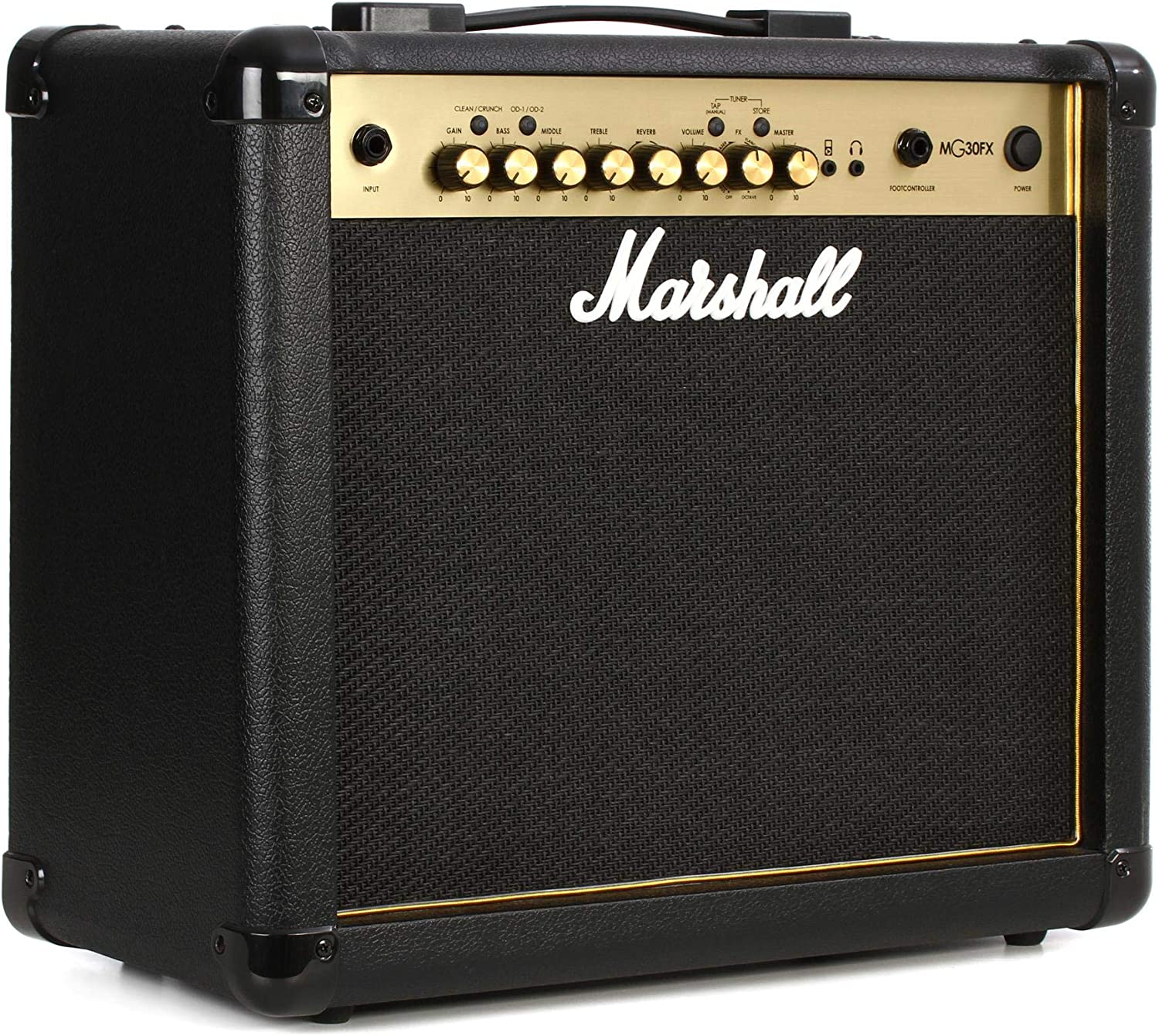
The amplifier should be made from durable materials that can stand up to the rigors of transportation, such as sturdy plastic, metal, or wood.
Additionally, the amplifier should have reinforced corners and edges to protect it from bumps and impacts during transportation.
Another crucial factor to consider is ventilation, solid-state amplifiers generate a lot of heat during use, which can cause damage or reduce their lifespan.
To prevent this, ensure the amplifier has proper ventilation, such as vents or fans, to dissipate the heat.
You should also check for any loose parts or rattling sounds when the amplifier is turned on, since loose parts could cause malfunctions or damage to the amplifier.
– Price
When purchasing a solid state amplifier, price is often an important consideration.
Solid state amplifiers are generally less expensive than tube amplifiers, but prices vary greatly depending on the brand, features, and quality.
Before making a purchase, it’s important to determine your budget and what features you need in an amplifier.
Consider what type of playing you will be doing and what venues you will be playing in.
Starting and playing primarily at home, you may not need a high-powered amplifier with many features.
If you plan on gigging or playing in larger venues, you’ll likely need a more powerful amplifier with additional features like multiple channels and effects.
It’s also important to factor in the cost of any additional accessories or cables you may need.
For example, if you plan on using a footswitch, make sure to factor in the price of purchasing one if it’s not included with the amplifier.
When comparing prices, don’t just look at the sticker price, consider the overall value for your money, including the build quality, features, and warranty the manufacturer offers.
It is worth spending more upfront for an amplifier that will last longer and provide more features in the long run.
What are the advantages of using a solid state amplifier?
One of the most significant advantages of solid-state amplifiers is their affordability, since tube amplifiers can be costly, especially those made by high-end manufacturers.
This can be a barrier for beginner and intermediate guitar players who are just starting and need more money to spend on equipment.
Solid-state amplifiers, tend to be more affordable than tube amps, making them accessible to a broader range of guitar players.
These are also highly reliable and require less maintenance than tube amps.
A researn why is that tubes have a limited lifespan and must be replaced every few years, which can be costly and time-consuming.
Solid-state amplifiers, do not use tubes and are less prone to breakdowns, so this makes them a popular choice among gigging musicians who need dependable gear that can withstand the wear and tear of regular use.
Another advantage of solid-state amplifiers is their portability.
Solid-state amplifiers are often more lightweight and compact than tube amps, which makes them easier to transport to gigs and rehearsals.
Many models also come with built-in handles or casters, enhancing their portability.
This is particularly important for gigging musicians who need to be able to move their gear quickly and easily.
Solid-state amplifiers are also very versatile in terms of the tones and sounds they can produce.
They can have a wide range of sounds, from clean and crisp to distorted and heavy.
In addition, many models come with built-in effects and EQ controls, which allow guitar players to tailor their sound to their specific needs and preferences.
This versatility makes them a popular choice among guitar players who play different genres of music and need an amplifier that can handle a range of styles.
Solid-state amps are also well-suited to high-gain genres like metal, as they can produce a lot of distortion without sacrificing tone quality.
This makes them a popular choice among metal and hard rock guitarists who need an amplifier to deliver a heavy, distorted sound without sacrificing tone quality.
In addition, solid-state amplifiers are generally more consistent in their sound output, which can be beneficial for guitar players who want reliable and consistent sound during performances or recording sessions.
Are solid state amplifiers more durable than tube amplifiers?
Solid-state amplifiers are known for their high reliability and durability compared to tube amplifiers.
This is because solid-state amplifiers use solid-state components such as transistors, diodes, and integrated circuits less prone to wear and tear than the vacuum tubes used in tube amplifiers.
Unlike tube amplifiers, solid-state amplifiers do not require regular tube replacements or other servicing, which can be expensive and time-consuming.
Solid-state amplifiers are also less prone to overheating, which can cause damage to the amplifier’s components and affect its sound quality.
This is particularly important for gigging musicians who need a reliable amplifier that can withstand frequent use and travel demands.
In addition to their reliability, solid-state amplifiers are also more durable than tube amplifiers.
Solid-state amplifiers are typically made using rugged materials such as metal and heavy-duty plastic that can withstand bumps, scratches, and other types of damage.
On the other hand, Tube amplifiers are often made using delicate glass tubes that can break or crack easily, affecting the amplifier’s sound quality and performance.
What is the ideal power rating for a solid state amp?
The ideal power rating for a solid-state guitar amplifier depends on your specific needs and intended use.
For home practice, a lower-wattage amplifier is typically ideal, as you don’t need a lot of power to get a good sound at home, and a miniature amplifier can be more affordable and easier to manage.
A solid-state amplifier with a power rating of 10-30 watts should be sufficient for home practice, allowing you to achieve a good sound at lower volumes without overwhelming your living space.
You will need a more powerful amplifier for gigging to ensure you can be heard over the other instruments on stage.
A solid-state amplifier with a power rating of 50-100 watts should be sufficient for most gigs, although the specific requirements will depend on the size of the venue and the volume levels you aim for.
A higher-wattage amplifier can also provide more headroom, allowing you to achieve a cleaner sound at higher volumes.
It is important to remember that a higher-wattage amplifier will also be larger and heavier, making it more difficult to transport to gigs.
For this reason, it’s crucial to balance power and portability when choosing a solid-state guitar amplifier for gigging.
The ideal power rating for a solid-state guitar amplifier will depend on your specific needs and intended use.
It’s essential to consider venue size, volume levels, and portability when choosing the suitable amplifier for your needs.
How to set up and adjust the controls on a solid state amplifier?
Setting up and adjusting the controls on a solid-state guitar amplifier can be daunting, especially if you’re new to playing or using amplifiers.
Here are some tips to help you get started:
– Start with a clean slate: Ensure all EQ settings and effects are turned off before adjusting controls. This will give you a neutral starting point from which to work.
– Adjust the gain: The gain control on your amplifier determines how distorted your sound will be. If you’re playing clean, set the gain low. If you want more distortion, turn up the gain.
– Adjust the EQ: The EQ controls on your amplifier allow you to shape your tone. Generally, you’ll have controls for bass, midrange, and treble. Experiment with these controls until you find a sound that you like.
– Add effects: If you have any effects pedals, now is the time to add them to your signal chain. Reverb, delay, and chorus are all widespread effects that can add depth and character to your sound.
– Adjust the volume: Once you’ve dialed in your tone, adjust the volume to your liking. If you’re playing at home, you won’t need to turn it up too loud. If you’re playing a gig, you must turn it up enough to be heard over the other instruments.
– Fine-tune your sound: Once the basic settings are dialed in, you can start fine-tuning your sound. Try adjusting the EQ or adding more effects until you get the sound you’re looking for.
Setting up and adjusting your solid-state guitar amplifier controls is a process that invites creativity and exploration.
This journey towards discovering the perfect tone for your playing style can be both fun and educational, as it helps you understand how different settings affect your sound.
When experimenting with your solid-state guitar amplifier, don’t be afraid to explore various combinations of settings.
Another critical aspect of achieving an excellent tone is your choice of guitar, as different guitars will respond differently to various amplifier settings.
Experimenting with different guitars, if possible, will allow you to find the best combination for your preferred sound.
Keep in mind that your playing technique is just as important as your equipment.
Make sure to practice and refine your skills, as this can greatly influence your overall sound.
Focus on areas such as picking, strumming, and fretting hand techniques, as well as your use of dynamics and expression.
A well-rounded playing style will ultimately contribute to a richer, more satisfying tone.
In love with guitars, and gear; expert in all things music! Been writing about guitars for about 5 years and counting. Born in the ’90s. Alma Mater: University of Havana. Always curious, trying to understand the world. #TeamFender

